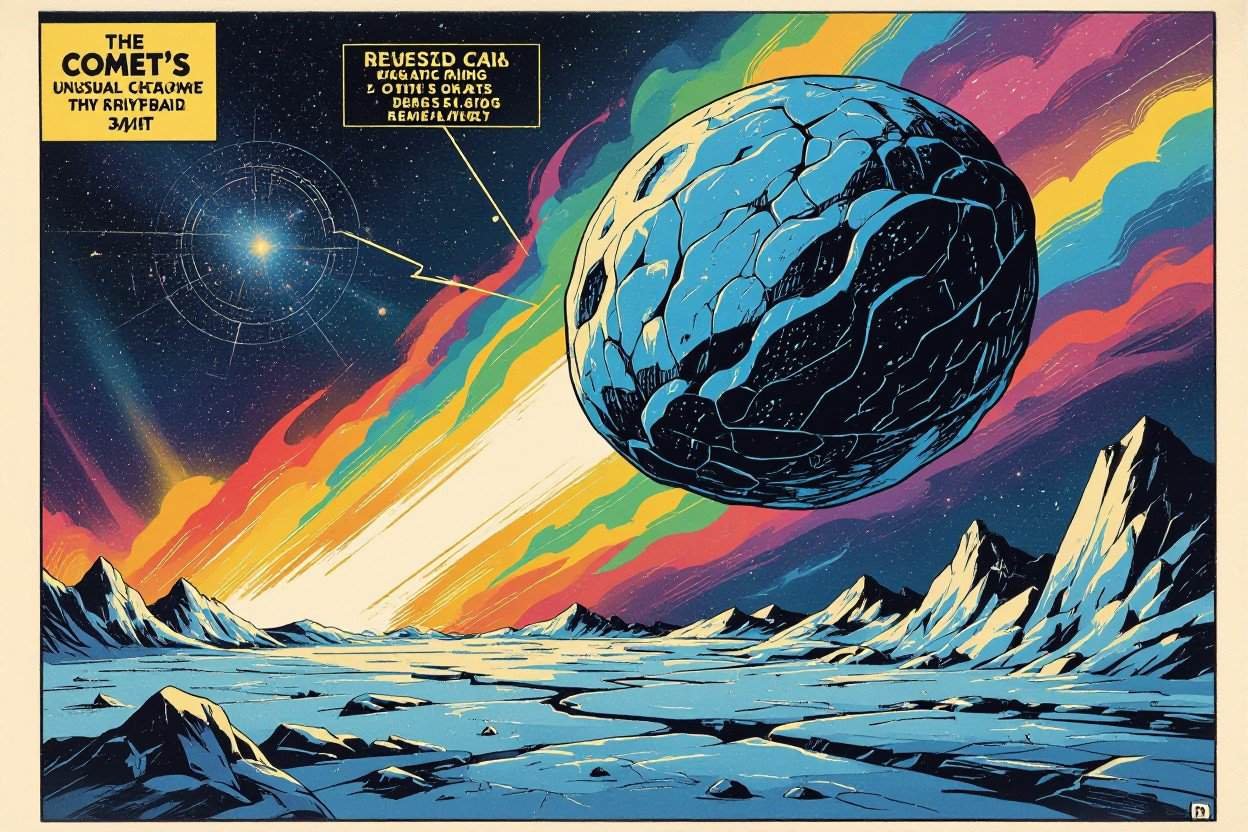3I/ATLAS is confirmed interstellar: it follows a hyperbolic, unbound trajectory that marks it as extrasolar. Pre-discovery images extend back to May 2025, and Hubble-based estimates place the nucleus below 1 km (reported range 0.32–5.6 km). It poses no impact threat — it never approaches closer than 1.8 AU (≈270 million km) to Earth.
Its coma is dominated by CO₂, with a measured CO₂:water mixing ratio near 8:1 — the highest ratio seen in any comet to date. Spectra show a red continuum and detect CO₂-dominated gas plus water ice and vapor, CO, carbonyl sulfide, cyanide gas and atomic nickel, along with dust consistent with D‑type asteroids. These signatures make 3I/ATLAS compositionally distinct from 1I/ʻOumuamua and 2I/Borisov.
Observers reported a strange green glow in September 2025, and imaging shows 3I/ATLAS has developed what is described as the fastest tail yet observed for an interstellar visitor. These evolving features give us a rare, time-resolved window on interstellar volatile chemistry and dust processing as the object interacts with the Sun.
Mars flyby opportunity (around 2025‑10‑03) may allow spacecraft in Mars orbit to capture high-resolution images and ultraviolet spectra beyond Earth-based capabilities. From the ground, 3I/ATLAS will be lost in solar glare at perihelion but should return to visibility in late November through December 2025, opening follow-up windows for spectroscopy and imaging.
Scientific payoff is large: 3I/ATLAS likely represents a remnant from early Milky Way star formation, informing models of planetesimal formation and volatile distribution. Some teams have noted the object’s unusual variability and trajectory and continue monitoring for technosignatures, though that possibility remains speculative.

Launching into the Cosmos: Discovery Timeline
When you trace the discovery of 3I/ATLAS, you see a rapid sequence of detections that transformed an obscure streak in survey images into one of the most studied interstellar visitors in recent memory. Pre-discovery images from as early as May 2025, captured by TESS and other facilities, showed the object already active before it was flagged in July, and those images let us reconstruct its early activity and brightness evolution. From the outset you should note that its orbit proved hyperbolic and unbound, a defining characteristic that confirms its interstellar origin and set the astronomical community to mobilize telescopes worldwide.
As you follow the timeline into late summer and early fall of 2025, observations rapidly multiplied: spectroscopy and imaging from ground and space telescopes refined the physical picture while Hubble provided a size constraint that placed the nucleus at an estimated less than 1 km wide with a broad range reported between 0.32 and 5.6 km. Those constraints, combined with the early activity seen in pre-discovery frames, told us that you were witnessing an actively outgassing body rather than a dormant interstellar rock. In September 2025 the object surprised observers again when reports emerged of a strange green glow and images revealed the development of the fastest tail ever observed from an interstellar visitor, prompting intensified follow-up across multiple wavelengths to capture rapid compositional and morphological changes.
Across this discovery arc you and your colleagues in the observing community benefited from a rare, convergent observing window: space telescopes, Mars orbiters, and an array of ground facilities coordinated campaigns to fill gaps caused by solar glare and evolving observability. Importantly, the object will be unobservable from Earth during perihelion because of that glare, but it is forecast to return to ground-based visibility in late November and through December 2025, offering another intensive study period. The sequence from pre-discovery detection to the September surprises underscores how quickly interstellar visitors can move from curiosity to major scientific target and how our global infrastructure responds when you point it at a rare opportunity.
A Journey Through Space: Trajectory and Velocity
When you examine 3I/ATLAS’s path through the solar system, the first fact that stands out is its hyperbolic, unbound trajectory, which mathematically demonstrates that it is not gravitationally captured by the Sun and is merely passing through. That hyperbolic trajectory is the principal evidence of its extrasolar provenance and implies that, after perihelion, it will continue outward, leaving the solar system again. For your perspective on risk assessment, you should note that the object is not a threat to Earth, with a minimum approach distance of never closer than 1.8 AU (≈270 million km), so while its path crosses the inner solar system regionally, it poses no collision hazard to our planet.
Velocity-wise, you can appreciate that interstellar objects travel at speeds and trajectories unlike typical bound comets, and 3I/ATLAS’s motion produced rapid changes in viewing geometry and illumination that shaped the observed growth of its coma and tail. The outgassing—dominated by CO₂—has driven dramatic coma and tail evolution as the object moved toward perihelion, producing non-linear brightening and structural changes that you can track across datasets. Because the object will pass relatively close to Mars around October 3, mission orbiters at Mars have provided and may continue to provide high-resolution images and ultraviolet spectra that complement Earth-based observations and give you multiple vantage points to measure its velocity vector and how activity modifies apparent motion.
Beyond observational opportunities, the trajectory informs scientific inference: because 3I/ATLAS is unbound, you and your colleagues can treat its composition and activity as a snapshot of material that formed around another star and was transported into our neighborhood. The combination of an interstellar incoming velocity, the observed CO₂-dominated coma chemistry, and the rapid tail development means that in measuring its speed, direction, and evolving outgassing you are directly probing how extrasolar planetesimals respond to solar heating—data that refine models of formation and irradiation in other protoplanetary environments.
In addition to path geometry, you should consider how trajectory timing determines observing strategy: the object’s perihelion passage makes it briefly unobservable from Earth, yet its predicted closest approach distance and October passage near Mars create a narrow window in which Mars-orbiting spacecraft can secure unique, close-range ultraviolet and high-resolution imagery, so we and you must coordinate timing to capture the transient, velocity-driven phenomena that reveal how its CO₂-rich volatile budget drives tail formation and morphological changes.

The CO₂ Puzzle: Dominance in Chemical Makeup
When you examine 3I/ATLAS, the first thing that forces your attention is the overwhelmingly CO₂-rich coma and tail: spectroscopic data show a CO₂:water mixing ratio of roughly 8:1, far higher than any solar-system comet or even the other interstellar visitor, Borisov. You will note that JWST and other facilities detected a red continuum with abundant CO₂ alongside water ice and vapor, plus trace species such as CO, carbonyl sulfide, cyanide gas, and even atomic nickel — a chemical mix that implies formation or processing under conditions that are markedly different from the comets you study in our system. This CO₂ dominance is the single most defining chemical signature of 3I/ATLAS and shapes both the physics of its activity as it approaches the Sun and the interpretation of its origin.
As you follow the evolving coma, you will see how the heavy CO₂ content alters the comet’s behavior: CO₂ sublimates at lower solar heating than water at the distances where 3I/ATLAS was observed to be active, which explains significant activity even at relatively large heliocentric distances and the rapid growth of the tail — now described as the fastest tail ever observed from an interstellar visitor. The presence of water ice and dust typical of D-type asteroid material indicates a mixed heritage in volatile and refractory components, so you must reconcile a high-CO₂ volatile inventory with the dust and ice textures you expect from primitive planetesimals. The detection of carbon-13 in CO₂ hints at isotopic signatures that you can use to infer formation locale in its birth disk, with implications for whether the object formed near the CO₂ ice line or was heavily processed by radiation.
You will also want to factor observational constraints into your interpretation: pre-discovery images from TESS and other facilities show 3I/ATLAS was active as early as May 2025, and Hubble-derived nucleus estimates place the size at under 1 km (range ~0.32–5.6 km depending on assumptions), making this a small but compositionally extreme body. Importantly, the object poses no hazard to Earth — it never comes closer than 1.8 AU (≈270 million km) — but the chemistry itself is a valuable scientific resource: it offers you and your colleagues an unprecedented look at CO₂-dominated planetesimals and forces you to re-evaluate models of volatile trapping and migration in extrasolar disks. Strong isotopic and molecular peculiarities make this an exceptional target for follow-up as it moves through the inner system.

Spectroscopic Revelations: The Green Glow Mystery
The spectral profile of 3I/ATLAS stands apart from most solar system comets. Its red continuum contrasts with a coma dominated by carbon dioxide, showing an unprecedented CO₂-to-water ratio of roughly 8:1. JWST data also reveal water ice and vapor, CO, carbonyl sulfide, cyanide gas, atomic nickel, and D-type asteroid-like dust. These combined signatures define 3I/ATLAS as a chemically distinct object—an evolving laboratory for studying photochemistry under solar irradiation.
The mysterious green glow reported in September defies the usual emissions tied to diatomic carbon or CN. Given the dominance of CO₂ and detection of atomic nickel, alternative excitation pathways must be considered—perhaps fluorescence or metallic line emissions triggered by high-energy solar photons. Pre-discovery spectra from May 2025 show the object was already active, letting us track evolving emission lines and transient processes that likely produce the glow.
Two immediate implications emerge:
- The extreme CO₂ abundance, including isotopically heavy carbon, suggests formation near a CO₂ ice line or heavy irradiation in its home system.
- The unusual emissions call for ultraviolet and high-resolution visible spectra—particularly as it nears Mars—to identify excitation mechanisms and refine gas production models.
Importantly, 3I/ATLAS follows a hyperbolic, interstellar trajectory and poses no threat to Earth, never coming closer than 1.8 AU (≈270 million km).
Deciphering the Tail Dynamics
As 3I/ATLAS approaches perihelion, its coma and tail expand rapidly, forming the fastest tail ever recorded for an interstellar object. This acceleration stems from CO₂-driven outgassing, which transfers momentum to dust grains differently than water-dominated comas. With a nucleus likely under 1 km across, even a modest active fraction can drive brisk dust ejection and small-particle acceleration.
Tail formation depends on gas drag, solar radiation pressure, and solar wind interaction. A CO₂-rich coma changes these dynamics—its gas expansion velocities and photodissociation pathways differ, creating distinctive ion-tail signatures and dust-to-gas coupling. The presence of atomic nickel and carbonyl sulfide further complicates tail brightness and plasma behavior.
High-resolution imaging and ultraviolet spectroscopy—especially from Mars orbiters as the comet nears Mars around October 3—will be vital while ground-based telescopes lose sight during perihelion. Pre-discovery data from May 2025 extend the timeline enough to distinguish steady CO₂-driven activity from transient outbursts.
Current models suggest the rapid tail reflects a dominance of fine, submicron grains that respond quickly to radiation pressure, producing narrow, fast-moving dust streams and abrupt shape changes with solar-wind variations. Mars-orbit and Earth-based coordination will allow a 3D reconstruction of these dynamics.
Insights into Solar System Formation
3I/ATLAS provides new data on planetesimal formation and migration. Its hyperbolic path confirms an interstellar origin, and Hubble estimates place the nucleus under 1 km. Pre-discovery images from May 2025 reveal sustained activity far from the Sun, allowing rare insight into early thermal behavior.
Spectroscopy confirms a CO₂-dominated coma with an 8:1 CO₂-to-water ratio—the highest on record—alongside water ice, CO, carbonyl sulfide, cyanide gas, and atomic nickel. The D-type dust signature suggests formation near or beyond a CO₂ ice line, or in regions heavily irradiated. These clues refine models of volatile partitioning and retention in planet-forming disks.
As the coma and tail evolved with solar heating, we witnessed green emission and an exceptionally fast tail, both likely tied to non-thermal or photochemical effects. The comet’s upcoming visibility windows—Mars in early October, then Earth again in late November–December—offer chances to link these real-time processes to the chemistry of extrasolar building blocks.
Bridging Interstellar and Planetary Science
3I/ATLAS bridges extrasolar and planetary studies by extending the small but growing catalog of interstellar visitors. Unlike ʻOumuamua (inactive) and Borisov (CO-rich), 3I/ATLAS shows extreme CO₂ dominance and a red spectrum. These contrasts expand our understanding of volatile diversity across planetary systems.
Its composition hints at formation near the CO₂ ice line or under prolonged energetic processing that depleted water. Integrating isotopic and compositional data into models will clarify how volatiles distribute and survive during planet formation—and how materials like organics and ices travel between stars. The detection of atomic nickel and complex volatiles strengthens links between distant disk chemistry and planet formation mechanisms.
Observations from JWST, Hubble, ALMA, and Mars orbiters give a rare multiwavelength look at how interstellar material reacts to solar heating—testing theories of volatile retention, dust-gas separation, and irradiation. The comet’s safe 1.8 AU minimum distance allows aggressive observation campaigns through late 2025.
Upcoming Events and Visibility Windows
During perihelion, 3I/ATLAS will be hidden by solar glare but reappear to Earth-based observers by late November through December 2025—the prime window for detailed follow-up. Pre-discovery detections from May 2025 and its compact (<1 km) nucleus mean brightness will vary with activity.
Because it never approaches Earth closer than 270 million km, 3I/ATLAS poses no hazard but will remain faint. Post-perihelion observations will be crucial for capturing the expanding tail and tracking chemical evolution. Coordinated efforts—spanning space telescopes, ground-based observatories, and amateur networks—will maximize coverage and catch any renewed outbursts or morphological changes.
Mars Missions and Their Contributions
As 3I/ATLAS passed near Mars around October 3, 2025, orbiters such as MAVEN and the Emirates’ Hope mission provided high-value UV spectra and imagery unavailable from Earth during solar conjunction. These datasets reveal volatile abundances, ionization states, and inner-tail structure from unique angles.
Mars orbiters aren’t designed for comet intercepts but can still deliver critical UV and imaging data. Cross-validation of volatiles already detected—CO₂, water, CO, carbonyl sulfide, cyanide gas, and nickel—will refine production-rate models and coma dynamics. Combining these results with later Earth-based data will yield a comprehensive 3D model of coma morphology and volatile behavior.
Despite operational limits and narrow timing, even a few well-timed Mars observations could greatly advance understanding of interstellar comet chemistry and solar-wind interaction.
Summary
3I/ATLAS is a confirmed interstellar comet on a hyperbolic, unbound path—small (under 1 km), CO₂-dominant, and chemically unlike any known solar-system comet. It was active months before discovery and exhibits a mysterious green glow and a record-breaking fast tail. The CO₂:water ratio of ~8:1 points to formation near a CO₂ ice line or under intense irradiation, offering direct evidence of chemical diversity in extrasolar systems.
This object poses no threat to Earth and will remain a focus of scientific—not defensive—interest. Observations from Mars in October and from Earth later in 2025 will let researchers connect composition, tail dynamics, and photochemistry to models of planet formation and interstellar material exchange across the Milky Way.
| Property | Value / Notes |
|---|---|
| Dominant volatile | Carbon dioxide (CO₂), CO₂:water ≈ 8:1 |
| Other detected species | Water ice/vapor, CO, carbonyl sulfide, CN, atomic Ni, D-type dust |
| Nucleus size | Estimated 0.32–5.6 km (Hubble constraints; likely <1 km) |
| Activity timing | Active in pre-discovery images (May 2025); increased activity approaching perihelion |
| Hazard to Earth | Not a threat: perihelion distance >1.8 AU from Earth |
| Comparison of Interstellar Objects | Key differences |
| 1I/ʻOumuamua | Asteroid-like, no detected outgassing; unusual non-gravitational acceleration |
| 2I/Borisov | Cometary, water-dominated with extremely high CO (9–26× typical) |
| 3I/ATLAS | CO₂-dominated, CO₂:water ≈ 8:1, green glow, fastest tail observed |


